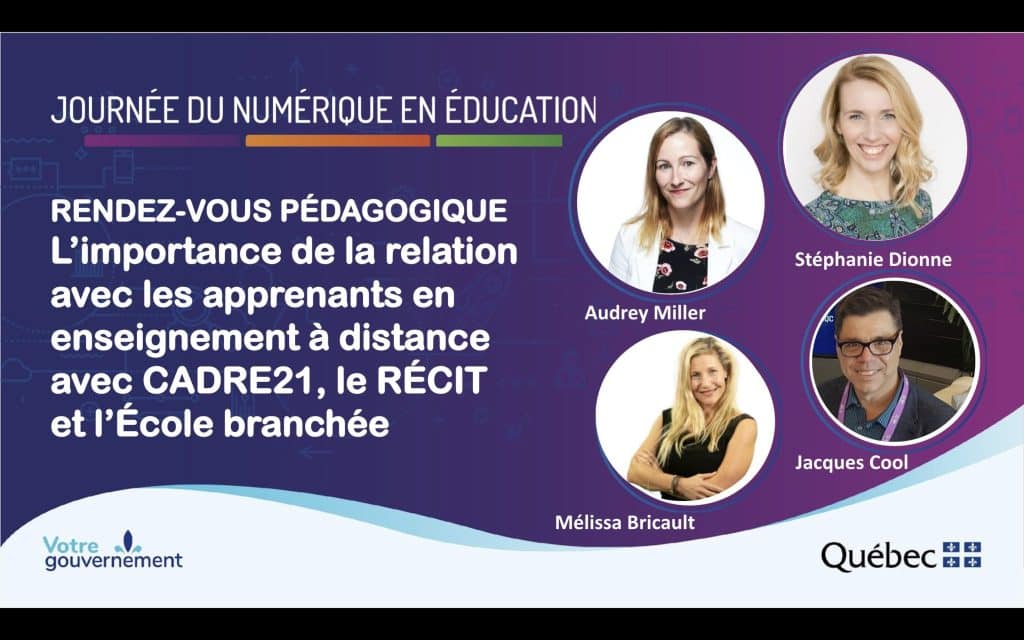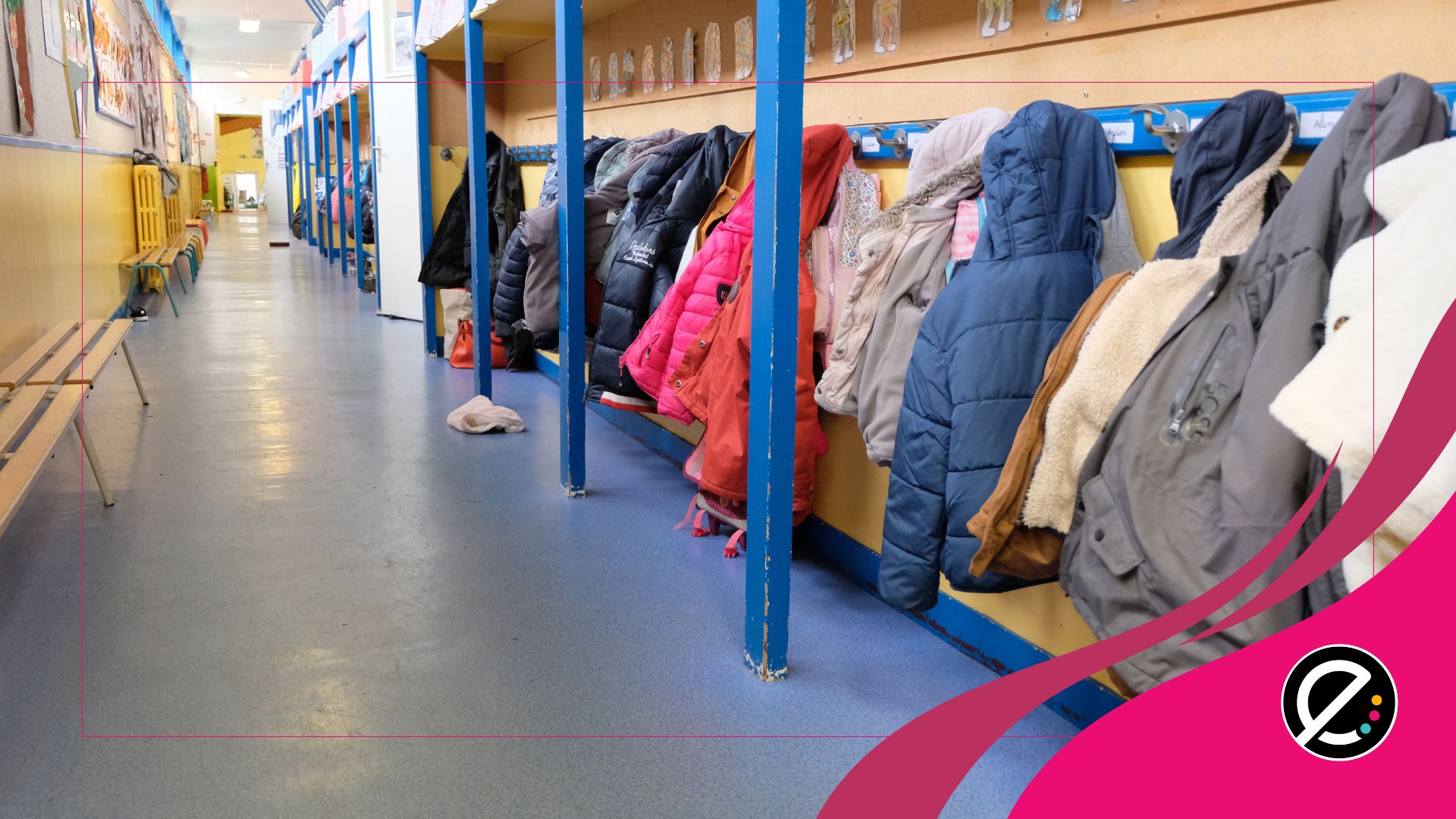La Journée du numérique en éducation (JNÉ) s’est ouverte ce matin par les allocutions et échanges avec les ministres de l’Éducation Jean-François Roberge et de la Transformation numérique Eric Caire, qui ont été suivis d’une intéressante conférence sur l’enseignement à distance de Cathia Papi, professeure au Département Éducation de l’Université TÉLUQ et responsable de la formation J’enseigne à distance.
Par la suite, les inscrits ont pu entendre un rendez-vous pédagogique en direct animé par Stéphanie Dionne de l’École branchée. Une belle occasion de discuter de l’importance de maintenir le lien enseignant-élève lorsque l’enseignement se transporte en dehors des murs de l’école.
Au-delà de la technologie, l’enseignement à distance représente un défi humain et relationnel de taille. Il ne faut jamais oublier l’humain derrière l’écran. Ce message était porté par les trois intervenants : Mélissa Bricault, conseillère pédagogique au RÉCIT local du Centre de services scolaire de la Seigneurie-des-Milles-Îles, Audrey Miller, directrice générale de l’École branchée, et Jacques Cool, directeur général du CADRE21.
Quel est le point de départ quand on se préoccupe du maintien du lien à distance?
Pour Mme Bricault, il est primordial de créer des moments de socialisation avec les élèves au début des cours à distance. « Prenons le temps de dialoguer avec les élèves avant de tomber dans le contenu. Amenons-les à nommer leurs émotions. Un jeune qui porte un bagage émotif ne pourra pas orienter ses pensées vers l’apprentissage. »
« Remplaçons notre anxiété numérique par de la bienveillance numérique », a résumé pour sa part M. Cool. Selon lui, il importe d’accompagner, de collaborer et co-élaborer, d’appuyer et de respirer dans un contexte extraordinaire comme celui que nous visons tous en ce moment. C’est le sentiment d’efficacité personnelle de chacun qui s’en trouvera augmenté.
« Il y a des différences, mais aussi des similitudes dans le fait d’enseigner et d’apprendre en classe et à distance », fait remarquer Audrey Miller. Pour elle, il faut prendre le temps de départager les préoccupations technologiques et humaines, travailler l’une et l’autre pour gagner en confiance, puis les joindre ensemble ensuite. « Ce qui unit tout ça, c’est l’importance du lien affectif. » Oui, le côté technique freine parfois les enseignants, mais il existe aussi des façons de l’utiliser avantageusement. « Pour être en mesure de garder, voire développer le lien, il faut à mon avis développer un minimum de compétence numérique de base, d’abord pour se sentir en confiance, puis pour continuer à offrir des occasions pédagogiques variées, faire de la différenciation, avoir recours à plusieurs médias, favoriser le travail d’équipe, etc. Il faut toutefois rester centré sur l’intention pédagogique, le but ultime visé, car c’est facile de s’égarer », précise-t-elle.
Elle a aussi abordé l’épineuse question « doit-on obliger les jeunes à ouvrir leur micro ou leur caméra? » Pour elle, « c’est une question technique. Si on la prend du côté de l’intention et de l’humain, est-ce que ça nous indique que quelque chose dans notre organisation pédagogique pourrait possiblement être modifié? »
Alors, sur quoi se concentrer pour maintenir le lien?
Au moment où la fatigue plane sur plusieurs, Audrey Miller a proposé 3 conseils.
- Porter attention à la variété des canaux de communication qu’on peut ouvrir avec les élèves : « Parce qu’au départ, s’il n’y a pas de canal, il n’y a rien qui passe! Par exemple, certains ont besoin de se faire demander comment ils vont avant d’être disposés à travailler. D’autres ont besoin d’être rassurés en voyant un plan de travail, ou en comprenant à quoi ça va leur servir. Certains ont besoin d’obtenir ou de provoquer une réaction, “lâcher leur fou”. Certains vont venir naturellement chercher de l’aide auprès de l’enseignant, d’autres ont besoin que l’enseignant vienne à eux. »
- S’intéresser ensuite aux meilleures pratiques destinées à tisser le lien en classe, telles que celles identifiées par la recherche en apprentissage socio-émotionnel (en anglais : social emotional learning). « Selon les experts, ces pratiques fonctionneront aussi à distance, car ce sont justement les “meilleures pratiques”! Des exemples : mentorat, tutorat entre les élèves, du temps pour discuter du processus, échanger du feedback, des lieux communs où discuter et s’entraider même en dehors des heures de classe (ex. Instagram), un comité d’engagement comprenant à la fois enseignants et élèves, etc. »
- Enfin, investir dans son développement professionnel au niveau de la compétence numérique. « Si vous ne vous sentez pas à l’aise avec la base, le reste est plus difficile, et c’est normal. »
Plusieurs enseignants s’inquiètent de l’application des règles de vie dans l’enseignement à distance. À cet effet, Mélissa Bricault suggère d’ouvrir le dialogue avec les élèves. « Amenons-les à réfléchir sur leur utilisation du numérique. Travaillons en amont avec eux. N’hésitons pas à faire une place aux parents dans cette discussion. Je suis convaincue que cela permettra d’éviter des situations désagréables. Ce sera au bénéfice de tous. »
Jacques Cool estime que les enseignants doivent miser sur leur créativité pédagogique afin de traverser la période actuelle et d’adapter leur pratique. « Les ressources sont là pour les enseignants. Le panorama n’a jamais été aussi bien garni afin de (se) mobiliser, s’engager pour réaliser de nouveaux apprentissages professionnels. Surtout, ils ne doivent pas vivre ce moment seul, dans l’isolement ».
Le mot de la fin lui revient certainement : « À chacun son Mont Everest. Nous devons tous entamer notre ascension. Personne ne peut rester au camp de base! »
À vous de jouer
Le rendez-vous pédagogique s’est conclu par une question posée aux participants : Si vous étiez un élève à distance de quoi auriez-vous besoin pour sentir que votre enseignant est là pour vous? Tous sont invités à répondre : monurl.ca/elevejne
Nous vous reviendrons avec un résumé des réponses dans les prochains jours!
Notez aussi que la rediffusion sera proposée sur la chaîne YouTube du ministère de l’Éducation dans les prochaines semaines.
Ressources complémentaires
- Fascicule pédagogique L’ENSEIGNEMENT HYBRIDE ou à DISTANCE au SECONDAIRE, Chapitre « Comment favoriser le lien entre les enseignants et les élèves à distance? »
- [Formation] CréaCamp 20 novembre 2020 (9h à 12h) Instaurer un climat propice aux apprentissages et planifier dans une approche inclusive et universelle pour mieux s’adapter à la situation actuelle. Facilité par Amélie Bédard, CSS des Premières-Seigneuries.
- [Vidéo] RDV pédagogique La Process Communication au service de la différenciation pédagogique avec Éric Théroux, enseignant de 6e année – École de la Source, CSS des Affluents.
- [Article] Dionne, S. (2019, juin) Un modèle de communication au service de la relation enseignant-parent. École branchée sur la famille.
- [Vidéo] RDV pédagogique La Process Communication : 6 langages au service de la relation enseignant-parents avec Karine Duperré (Se Comprendre)
- [Article] Bédard A. (2020, novembre). Et si la façon d’atteindre le plein potentiel de nos élèves passait par leur cœur?. Professionnelle à l’inclusion scolaire, CSS des Premières Seigneuries. École branchée.
- « Entrer en contact avec les élèves à distance peut soulever un ensemble de questions éthiques pour lesquelles une réflexion préalable serait utile. Il s’agit de faire preuve de prévoyance et de bienveillance, sans toutefois semer la peur face à des dangers potentiels qui, au final, pourraient engendrer les problèmes que l’on voulait éviter. » Ces neuf principes inspirent nos actions en éducation – Benoit Petit, Service national du RÉCIT, Domaine du développement la personne (2020)
- 5 conseils pour co-élaborer un code d’éthique, (juin 2002), Service national du RÉCIT, Domaine du développement la personne
- « Une bonne gestion des émotions est associée au maintien de bonnes relations avec les autres, à une meilleure gestion des conflits ainsi qu’à la réussite scolaire. » NosEmotions.ca – Pistes et ressources, destinées aux familles, réalisées par Tina Montreuil, chercheure Université McGill, Benoit Petit, Mélissa Bricault et Marie-Soleil Carroll, personnes-ressources du RÉCIT (2020)
- Éduquer à une utilisation éthique du numérique, Mélissa Bricault, RÉCIT CSSMI (2020)






